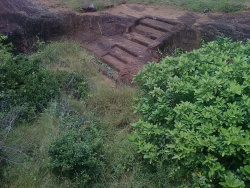Difference between revisions of "Pavurallakonda"
| Line 1: | Line 1: | ||
[[File:Rockcut_steps_to_a_large_cistern_pavurallakonda_Bheemunipatnam.jpg|thumb|250px|]] | [[File:Rockcut_steps_to_a_large_cistern_pavurallakonda_Bheemunipatnam.jpg|thumb|250px|]] | ||
| − | |||
| − | |||
| − | |||
| − | The Gosthani [[River]] which flows close by this site, also offers a panoramic view of the coastline. This site is contemporary with the nearby [[Buddhist]] sites in Visakhapatnam district like Bavikonda and Thotlakonda | + | '''[[Pavurallakonda]]''' or '''[[Pavurallabodu]]''' is the local [[name]] of a hill, popularly known as [[Narasimhaswamy konda]], near [[Bheemunipatnam]] about 25 km towards [[North]] from [[Visakhapatnam]] city. |
| + | |||
| + | It is located at a height of about 150 meters above {{Wiki|mean sea level}}. | ||
| + | |||
| + | [[Pavurallakonda]] consists of a ruined hill top [[Buddhist Monastic Complex]] probably witnessed [[human]] habitation from 3rd Century BCE to 2nd century CE. | ||
| + | |||
| + | It is one of the Largest [[Buddhist Monasteries]] of [[North]] Coastal [[Andhra]] Region. | ||
| + | |||
| + | [[Hinayana Buddhism]] must have flourished at this hill-top site. | ||
| + | |||
| + | Initial Excavation of this site yielded many [[relics]]. | ||
| + | |||
| + | Two [[Brahmi]] label {{Wiki|inscriptions}}, foundations of [[Viharas]], circular [[chaityas]], votive [[stupas]], halls etc are located among the ruins. | ||
| + | |||
| + | Coins, polished ware, beads etc were recovered from the site by the [[state]] archaeology Department of [[Andhra Pradesh]]. | ||
| + | |||
| + | Nearly Sixteen rock-cut cisterns are carved on the hill for the storage of [[rain]] [[water]]. | ||
| + | |||
| + | Excavations and Restoration Program are under progress at [[Pavurallakonda]]. | ||
| + | |||
| + | The Gosthani [[River]] which flows close by this site, also offers a panoramic view of the coastline. | ||
| + | |||
| + | This site is contemporary with the nearby [[Buddhist]] sites in [[Visakhapatnam]] district like [[Bavikonda]] and [[Thotlakonda]] | ||
| + | |||
| + | The [[Indian]] National [[Trust]] for [[Arts]] and {{Wiki|Cultural}} Heritage (INTACH)has already appealed to the authorities to ensure better [[protection]] of [[Buddhist]] sites by [[taking up]] the declaration of [[Bavikonda]], [[Thotlakonda]], [[Pavurallakonda]] and [[Bojjannakonda]] as heritage sites by [[UNESCO]]. | ||
| + | |||
| + | This will not only pave the way for steady flow of funds but also generate employment opportunities for the locals. | ||
| − | |||
==Origin of the [[name]]== | ==Origin of the [[name]]== | ||
| − | [[Pavurallakonda]] in general gives the meaning as 'The Hill of the Pigeons' (pavuralu in telugu means pigeons and [[konda]] means hill).But as per some studies conducted at this site it may be known as [[Pavurallakonda]] due to the availability of white stone on the hillock (pavurallu means white stones locally). The origin of the [[name]] of this site needs clarification yet. | + | |
| + | [[Pavurallakonda]] in general gives the meaning as 'The [[Hill of the Pigeons]]' ([[pavuralu]] in [[telugu]] means pigeons and [[konda]] means hill). | ||
| + | |||
| + | But as per some studies conducted at this site it may be known as [[Pavurallakonda]] due to the availability of white stone on the hillock (pavurallu means white stones locally). | ||
| + | |||
| + | The origin of the [[name]] of this site needs clarification yet. | ||
{{W}} | {{W}} | ||
[[Category:Buddhist Caves]] | [[Category:Buddhist Caves]] | ||
Latest revision as of 05:41, 12 February 2016
Pavurallakonda or Pavurallabodu is the local name of a hill, popularly known as Narasimhaswamy konda, near Bheemunipatnam about 25 km towards North from Visakhapatnam city.
It is located at a height of about 150 meters above mean sea level.
Pavurallakonda consists of a ruined hill top Buddhist Monastic Complex probably witnessed human habitation from 3rd Century BCE to 2nd century CE.
It is one of the Largest Buddhist Monasteries of North Coastal Andhra Region.
Hinayana Buddhism must have flourished at this hill-top site.
Initial Excavation of this site yielded many relics.
Two Brahmi label inscriptions, foundations of Viharas, circular chaityas, votive stupas, halls etc are located among the ruins.
Coins, polished ware, beads etc were recovered from the site by the state archaeology Department of Andhra Pradesh.
Nearly Sixteen rock-cut cisterns are carved on the hill for the storage of rain water.
Excavations and Restoration Program are under progress at Pavurallakonda.
The Gosthani River which flows close by this site, also offers a panoramic view of the coastline.
This site is contemporary with the nearby Buddhist sites in Visakhapatnam district like Bavikonda and Thotlakonda
The Indian National Trust for Arts and Cultural Heritage (INTACH)has already appealed to the authorities to ensure better protection of Buddhist sites by taking up the declaration of Bavikonda, Thotlakonda, Pavurallakonda and Bojjannakonda as heritage sites by UNESCO.
This will not only pave the way for steady flow of funds but also generate employment opportunities for the locals.
Origin of the name
Pavurallakonda in general gives the meaning as 'The Hill of the Pigeons' (pavuralu in telugu means pigeons and konda means hill).
But as per some studies conducted at this site it may be known as Pavurallakonda due to the availability of white stone on the hillock (pavurallu means white stones locally).
The origin of the name of this site needs clarification yet.
